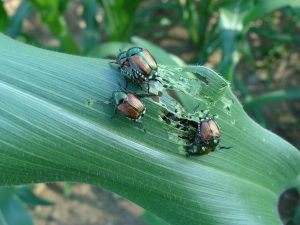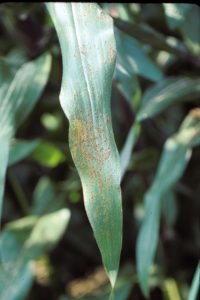Sweet Corn IPM Newsletter No. 8 — August 2, 2024
CORN EARWORM NUMBERS HIGHEST OF THE SEASON
Fall Armyworm and Western Bean Cutworm Numbers Also Higher
SITUATION

Warm weather has pushed sweet corn maturity this week. Late-planted varieties are catching up to earlier plantings, making it more challenging to schedule harvests and markets. Growers have been mostly pleased with quality, although dry conditions in the south have raised some concern for plantings just coming into silk.
European corn borer: Very few moths were caught in pheromone traps this week, with most locations catching none. No sites were over the spray threshold for moths in silking corn. Only one site showed any corn borer larval feeding damage, but this was well under threshold.
Corn earworm: Moth captures were higher this week at nearly all locations, indicating a tighter spray interval is now needed to prevent infestation in silking fields. A 5-day spray interval for silking corn was recommended in Palmyra, Bowdoinham and Farmington; a 4-day spray interval was recommended for Auburn, Biddeford, Cape Elizabeth, Dayton, Gray, Lewiston, Monmouth, Oxford, Wayne and Wells.
Fall armyworm: Moth counts in pheromone traps were higher at most locations this week. All sites, with the exception of Monmouth and Palmyra, were over the three-moth threshold for silking corn in pheromone traps, but all sites are presently under a spray interval for corn earworm, which should provide control of fall armyworm. Larval feeding damage was moderate in most pre-silking corn, but sites in Biddeford, Bowdoinham and Cape Elizabeth were over threshold of 12-15% of plants with fresh injury.
Western Bean Cutworm: Captures of moths in pheromone traps were generally higher at most locations this week, ranging from 13 to over 87 moths in a trap. Because its habit is very similar to fall armyworm, we recommend protecting silking corn when more than three moths are caught in traps, but for all farms scouted this week, sprays for corn earworm or fall armyworm should protect silking corn from western bean cutworm, and no additional control was recommended.
Japanese beetles have been infesting several crops this summer. These insects often find their way into cornfields and feed on the leaves, causing an interveinal skeletonizing, which is generally not significant. However, they may also feed on the silks of developing ears, causing poor tip fill. Sprays for European corn borer and/or corn earworm (except Bt’s) usually will control Japanese beetle as well.
Squash vine borer: Moth numbers in pheromone traps were below threshold at all locations this week, and no sprays were recommended. While this could indicate the end of the first generation of squash vine borer for the season, we sometimes see a second generation emerge late in the season to threaten late planted squash.

Corn rust: Rust is a fungus disease, which appears as reddish-brown pustules on corn leaves and husks, reducing the quality of the ears. A fungicide spray for rust is only recommended when the symptoms are seen prior to tasseling. Later infections are unlikely to cause enough damage to warrant control measures. Materials available to control corn rust include Quadris, Bravo®, and Quilt®.
Save the Date!
The New England Vegetable & Fruit Conference will be held in Manchester, NH December 17, 18, 19, 2024. Program and registration information will be coming soon. Visit the website: http://www.newenglandvfc.org/
Sincerely,
David T. Handley
Vegetable & Small Fruit Specialist
Highmoor Farm
P.O. Box 179
52 U.S. Route 202
Monmouth, ME 04259
207.933.2100
UMaine Extension Diagnostic Research Lab
Pest Management Unit
17 Godfrey Drive
Orono, ME 04473
1.800.287.0279
| Location | CEW Moths | ECB Moths | FAW Moths | WBC Moths | %Feeding Damage | Recommendations / Comments |
|---|---|---|---|---|---|---|
| Auburn | 49 | 0 | 19 | 69 | 7% | 4-day spray interval for silking corn |
| Biddeford | 19 | 1 | 39 | 15 | 23% | 4-day spray interval for silking corn |
| Bowdoinham | 4 | 0 | 25 | 56 | 25% | 5-day spray interval for silking corn |
| Cape Elizabeth | 81 | 0 | 45 | 24 | 18% | 4-day spray interval for silking corn |
| Dayton | 18 | 0 | 5 | 34 | 4% | 4-day spray interval for silking corn |
| Farmington | 5 | 0 | 9 | 54 | 5-day spray interval for silking corn | |
| Garland | 0 | 3 | 3 | 2% | One spray recommended for FAW on silking corn | |
| Gray | 79 | 0 | 47 | 87 | 9% | 4-day spray interval for silking corn |
| Lewiston | 36 | 0 | 16 | 43 | 0% | 4-day spray interval for silking corn |
| Monmouth | 24 | 1 | 0 | 36 | 4% | 4-day spray interval for silking corn |
| Oxford | 14 | 4 | 38 | 68 | 3% | 4-day spray interval for silking corn |
| Palmyra | 4 | 0 | 0 | 1% | 5-day spray interval for silking corn | |
| Wayne | 10 | 0 | 11 | 55 | 0% | 4-day spray interval for silking corn |
| Wells I | 52 | 0 | 6 | 19 | 11% | 4-day spray interval for silking corn |
| Wells II | 6 | 3 | 35 | 13 | 2% | 4-day spray interval for silking corn |
CEW: Corn earworm (Only fresh silking corn should be sprayed for this insect.)
ECB: European corn borer
FAW: Fall armyworm
CBW: Western bean cutworm
| Moths caught per week | Moths caught per night | Spray Interval |
|---|---|---|
| 0.0 to 1.4 | 0.0 to 0.2 | No spray |
| 1.5 to 3.5 | 0.3 to 0.5 | Spray every 6 days |
| 3.6 to 7.0 | 0.6 to 1.0 | Spray every 5 days |
| 7.1 to 91 | 1.1 to 13.0 | Spray every 4 days |
| More than 91 | More than 13 | Spray every 3 days |
Thresholds apply only to corn with exposed fresh silk. Lengthen spray intervals by one day if maximum daily temperature is less than 80°F.
European Corn Borer Thresholds
Whorl stage: 30% or more of plants scouted show injury.
Pre-tassel-silk: 15% or more of plants scouted show injury.
Silk: 5 or more moths caught in pheromone traps in one week.
IPM Web Pages:
Explore Integrated Pest Management in Maine — UMaine
Integrated Pest Management Data Visualization Tool — Penn State
Integrated Pest Management — UMass Amherst
Where brand names or company names are used, it is for the reader’s information. No endorsement is implied nor is any discrimination intended against other products with similar ingredients. Always consult product labels for rates, application instructions and safety precautions. Users of these products assume all associated risks.
In complying with the letter and spirit of applicable laws and pursuing its own goals of diversity, the University of Maine System does not discriminate on the grounds of race, color, religion, sex, sexual orientation, transgender status, gender, gender identity or expression, ethnicity, national origin, citizenship status, familial status, ancestry, age, disability physical or mental, genetic information, or veterans or military status in employment, education, and all other programs and activities. The University provides reasonable accommodations to qualified individuals with disabilities upon request. The following person has been designated to handle inquiries regarding non-discrimination policies: Director of Equal Opportunity, 5713 Chadbourne Hall, Room 412, University of Maine, Orono, ME 04469-5713, 207.581.1226, TTY 711 (Maine Relay System).
